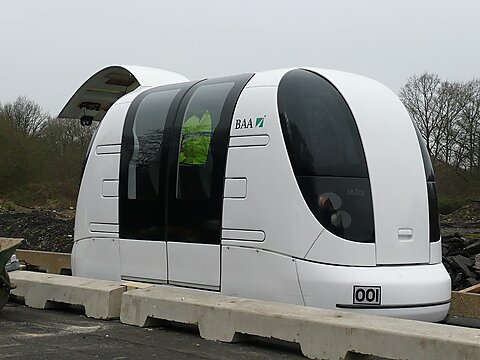The Contra Costa Transportation Authority (CCTA) has announced plans to install a new type of transit system in a suburban area 45 miles northeast of San Francisco. The system, created by transportation startup Glydways, offers some compelling efficiencies, but its application in a relatively low‐density area does not appear to be cost‐effective. As such, CCTA’s plan merits a hard look from both local and federal taxpayers who will be obliged to fund it.
Glydways’ system uses small driverless vehicles (with a capacity of up to four passengers) on a narrow, dedicated guideway. Because the vehicles use rubber tires, there is no need to install rail tracks. Vehicles are available on demand, typically within two to five minutes of being summoned on the Glydways app.
The Glydways solution addresses several criticisms of traditional rail transit projects, which involve large (often empty) vehicles operating on fixed schedules piloted by operators entitled to generous pension benefits. Projects of this type, including New York’s Second Avenue Subway and BART’s Silicon Valley extension, not only cost billions to build but they are also expensive to operate.
As such, Glydways offers much needed innovation in public transportation, perhaps because it is looking at the challenge from a startup lens. Formed in 2019, the company has raised over $70 million from a group of investors that includes Bill Gates and Vinod Khosla. Their solution is an interesting attempt to apply ideas pioneered by Uber and Waymo to the requirements of public transit.
But innovation alone is no assurance that government will use taxpayer money effectively. Incentives also have a role to play. When companies simply sell products and services to a public agency, they do not have a strong motive to economize. Indeed, they often benefit from cost overruns.
But the CCTA project promises to resolve this incentive problem by using the public‐private‐partnership (or P3) model. The P3 charged with delivering the East Contra Costa County Dynamic Personal Micro Transit (DPMT) project includes Glydways and four other companies, along with CCTA and the local public sector bus operator.
Under a P3, companies are supposed to take some ownership of the project. If a P3 truly transfers risk to the corporate partners, their interests better align with those of the taxpayer. In a transportation context, risk transfer means that private sector players should be required to absorb construction cost overruns, excess operational costs, and lower‐than‐expected fare revenues. But from the CCTA press release, it is not clear what risk Glydways and the other companies will be expected to shoulder.
And the risks are substantial. Because this is a system that has yet to be tried in a real‐world setting, a lot can go wrong with the vehicles and the dispatching technology. The unattended vehicles will be especially vulnerable to vandalism, which, unfortunately, is common in the San Francisco Bay Area.
Further, the cost and ridership projections for DPMT do not look promising. A 2021 presentation listed an annual ridership estimate of seven million, which works out to about 20,000 rides per weekday. The same presentation provided a capital cost estimate of $451 million. That seems like a lot of money to transport not too many people, and this is before operating costs are considered.
Further, if these numbers were re‐estimated in 2024, they will probably look worse. General inflation has pushed up costs for all construction projects. Meanwhile, ridership on the connecting mass transit line (known as eBART) is running about half of 2019 levels. Since the ridership model for DPMT appears to be based on 2019 transit utilization rates, it is likely that a new model based on post‐COVID transit use would project more modest ridership.
Potential utilization for DPMT is limited by the area’s relatively low population density. The four cities that would be served by the new transit system average about 4000 people per square mile, compared to over 7500 in Oakland and 17,700 in San Francisco.
Applying a new transit solution to this area sounds intriguing, but the relatively limited number of potential users may be more economically served by a new multi‐use trail with shared e‑scooter and e‑bike stations.

